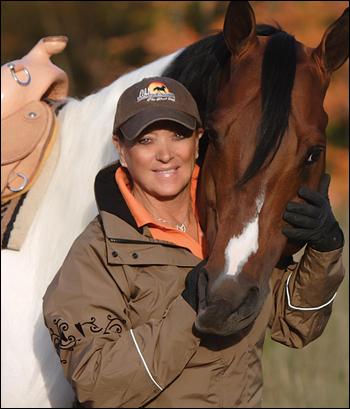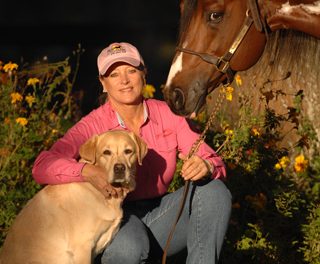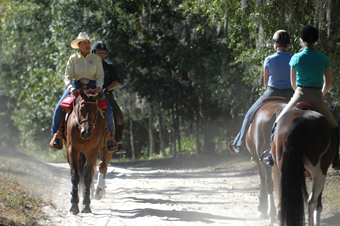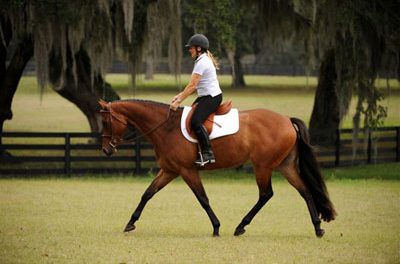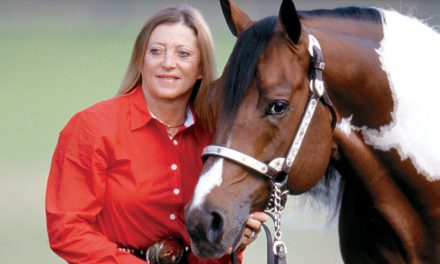BUILDING A PARTNERSHIP WITH YOUR HORSE
 The rider’s aids are the tools with which the rider communicates with his/her horse. The “natural” aids the rider uses are the seat, the legs, and the hands. The rider’s legs and seat control the two-thirds of the horse’s body from the withers back. The rider’s hands control the forward one-third of the horse’s body, including the shoulders, neck, and head. It is important to understand how each of these natural aids works.
The rider’s aids are the tools with which the rider communicates with his/her horse. The “natural” aids the rider uses are the seat, the legs, and the hands. The rider’s legs and seat control the two-thirds of the horse’s body from the withers back. The rider’s hands control the forward one-third of the horse’s body, including the shoulders, neck, and head. It is important to understand how each of these natural aids works.
The Seat
The rider’s seat works as an aid to help the horse go forward or slow down. The seat works by applying weight into the saddle on the horse’s back according to what response the rider wants. The rider uses more weight in her seat for more response and less weight for a lighter response.
The weight that the rider applies through her seat has two functions:
1. It indicates to the horse her desire to go forward or to slow down
2. It helps the horse accomplish these actions
The Legs
The rider’s legs work as an aid because the horse moves away from pressure. In moving away from the rider’s leg pressure, a horse can go forward, sideways, or backwards.
When the rider applies her legs to communicate with the horse, it should always first be done with the lightest squeeze possible slightly behind the girth.
If the rider does not get a reaction when a leg aid is lightly applied behind the girth, she should move her leg slightly farther back on the horse’s barrel and reapply the leg aid. To do this properly, the rider should move her leg back from her hip and only slightly bend her knee to bring her lower leg back. The heel should stay down. When the rider applies a leg aid farther back from the girth, it always is a stronger request to the horse to move his body. When using this stronger aid, the rider should avoid the common error of bending the knee to lift the lower leg higher on the horse’s barrel. This brings the heel up high on the horse’s side, which is not a good position for an effective leg aid.
If the horse does not respond when the rider brings her leg slightly farther back on his barrel, then the rider should use a vibrating leg pressure. Keeping her heel down, the rider should apply a rapid vibrating or on-and-off pressure with the side of her lower leg behind the girth. This is not the same as poking the horse with the heels. Poking and kicking irritates the horse and eventually makes him duller to the leg aids. A vibrating pressure should wake him up without a lot of excess squeezing.
If the horse still does not respond, use an abrupt action with the leg behind the girth. Again, it is done with the lower leg flat against the horse’s barrel and not with the heel. A quick, assertive bump behind the girth should get a reaction from the horse. When it does, the rider should go back to asking him with a light squeeze with the leg.
A golden rule of aids communication is that no matter what level of communication you use to get a response from your horse, always go back to the lightest aid possible.
The Hands
The rider’s hands control the reins. To give rein aids properly, the hands must be in the correct position in front of the saddle at all times.
The rider uses the reins for two purposes:
1. Speed control. This is achieved through the action of the rider’s fingers on the reins. With her hands holding the reins, the rider closes her fingers around the reins to ask her horse to slow down. When she wants her horse to go forward, she opens her fingers slightly to allow her horse the freedom to move forward.
2. Turning. The inside or positioning rein is on the side of the horse he is turning into– if he is turning to the left, the inside rein is the left rein. The positioning rein’s job is to position or direct the horse in the direction in which the rider wishes to travel. The outside rein is the turning rein. It is used to apply pressure to the outside of the horse’s neck until he turns away from the pressure.
In order to turn to the left, the rider moves her hand and left rein–the inside or position rein–sideways and slightly away from the horse’s neck. This should be done through the action of the elbow, not the wrist. And never pull back on the rein. Pulling back restricts the horse’s forward motion, and it is possible to do a turn without forward motion.
At the same time, the rider lays the right rein–the outside or turning rein–against the horse’s neck. The right hand should not cross over the horse’s neck. The horse should move away from the action or pressure of the turning rein and turn left. If more turning action is needed, the rider should slightly raise the outside hand to move the turning rein farther up the neck. If less turning action is desired or a lighter response is sought, the rider should keep the turning rein closer to the base of the horse’s shoulder.
Next time, I will share with you some exercises to improve the use of your seat, leg, and hand aids.
About the author
Lynn Palm teaches and coaches riders and horses. She also develops training and educational products. Learn more on Lynn’s Web site at www.lynnpalm.com.

